If you’re looking to rank a website on Google in 2025, link building SEO strategies are critical in getting its visibility where it needs to be. Link building remains of the top three ranking factors. All site owners need to put together a solid link building strategy that will help them earn high-quality backlinks.
Link Building SEO Strategies in 2025
The tactics and link building SEO strategies out there are numerous, and there are a multitude of different approaches.
For SEO beginners, it can be like drinking from a firehose. And you don’t want to be overwhelmed to the point where you’re confused where to begin and/or are more likely to do nothing than something.
And for SEO professionals that have been doing link building for years, there are always new tactics that you can pick up. So, we’ve laid out this guide to help streamline the process of SEO link building.
We’ll provide various strategies and tactics that you can take to earn those first page and top rankings.We also cover approaches that could waste time or resources and have a negative impact on your organic search visibility.
We will share tactics that include those that are straightforward and can provide “quick wins” as well as those that are longer term strategies that require planning.
Throughout this article, we will use SEMrush as our tool of choice for anything link and backlink related.
 |
SEMrush |
SEO Link Building Strategies Overview
We’ll cover the following:
- Intro to Link Building
- Link Building’s Importance to SEO
- Key Components to a Successful Link Building Strategy
- Link Building Techniques (White Hat vs. Black Hat vs. Gray Hat)
- Toxic Links and the Risks of a Bad Strategy
- Link Building SEO Strategies You Need to Know in 2025
- “Quick Win” Link Building Strategies
- Traditional Link Building Strategies
- How to Earn Links
- Paid Link Building Strategies
- Link Building Outreach
- Simple Ways to Find Link Building Opportunities
- How to Measure the Success of Your Link Building Campaigns
Let’s dive in.
Intro to Link Building
Link building is a vital part of any successful SEO strategy. The process involves getting other websites to link back to yours — i.e., a simple live hyperlink from one site back to your own.
It is also known as one of the most difficult parts of ranking a site, as getting these links is not easy. At the same time, it is one of the most rewarding when done well given the authority it can give to your site and raise your organic rankings.
How linking works
When site X links to site Y, this is a hint to Google’s algorithm that site Y should be ranking higher for relevant keywords.
You might see these referred to as backlinks, external links, inbound links, backlinks, or simply the basic term links.
Backlinks are like votes
The more high quality links you get back to your website — and become part of your backlink profile — the higher you should begin to rank on Google. It’s a matter of conveying trust and popularity.
Therefore, the more organic traffic you should receive as a direct result.
Backlinks nonetheless vary in quality. Some can even cause your website to decrease in visibility if the websites linking to you are spammy, something we’ll cover below.
There are many types of strategies you can use to build links. Some easier to do than others.
Knowing where exactly to get started can be difficult, given how large a subject SEO link building is.
And especially when you are aware that some backlinks can do more harm to your site than good.
Link Building’s Importance to SEO
Link building takes time and effort. There is no beating around that reality. Unlike paid advertising, where you can buy the traffic and get it, SEO link building is a long-term game.
It’s also not easy to do well. Those who can successfully execute link building strategies to get higher-quality links than their competitors will usually see material growth in organic traffic and their revenue.
Accordingly, link building should take up a considerable portion of your SEO — and perhaps overall marketing — resources.
Though link buying is off-limits based on Google’s Webmaster Guidelines, there are blogs and sites that will charge outsiders hundreds or even thousands of dollars for a single link to another website.
To summarize the main reasons you need to place a strong focus on SEO link building:
- You’ll rank higher on Google and other search engines, leading to higher organic search traffic with the increased visibility.
- Google and other search engines will find new pages you publish faster (often within hours).
- You will see increased credibility, popularity, and trustworthiness as a brand and business.
- You could benefit from the targeted referral traffic, as other relevant websites add your links to their content.
Not only should you build links back to your site, you will need to ensure you have link building strategies that can give you a competitive advantage.
We’ll show you how to do this in this guide.
Key Components to Successful Link Building SEO Strategies
Link building goes deeper than just complexity of the strategies employed.
When planning out a link building strategy, you will need to know that not all links are equal and that there are key elements that drive forward success. Namely, links shouldn’t be built blindly or treated equally.
Some are more authoritative and relevant than others.
In other words, you should know what a great link looks like and understand that the more effort that goes into getting the right links, the better results you’ll see.
Below are some of the key elements to focus on that make up a great SEO link building strategy to generate the best backlink profile possible.
1. A Relatively High Percentage of ‘Followed’ Links
Not all links will pass PageRank and positively (or negatively) impact a site’s rankings.
Links can have different types of attributes given to them.
The main ones you need to know to are nofollow, sponsored, and UGC (user-generated content) links.
Links that have a rel=”nofollow” attribute note that Google’s web crawlers should ignore them and should not associate the two sites for purposes of passing on “link juice.”
Rel=”sponsored” attributes will indicate that a link has been bought. Therefore it should not pass PageRank.
Rel=”UGC” are used for user-generated content. These include forums and comments on other blogs. It indicates that these links could be manipulative and are not there based on editorial discretion.
If a link is referred to as a ‘followed’ link (i.e., usually referred to as a ‘dofollow’ link, though that’s technically not the official terminology), it means that there are no rel= attributes that preclude PageRank from being passed.
An excellent backlink profile should contain a large percentage of followed links, as long as they are high-quality.
2. Contextual Links
Links on a page that are more likely to be clicked are generally those that have the most value.
Accordingly, they can have the largest impact on rankings. Google measures the value of a link through PageRank. Its ‘reasonable surfer model‘ parent states that different features of links change how Google treats the link for conveying authority.
Generally, the more prominent a link is — such as it being toward the top of a page, or at least in the main content area of a page — then it could pass along a quality amount of PageRank, depending on the authority of a site.
On the other hand, if it’s less likely to be clicked upon, such as being in the footer of a page or it uses footer text that’s not as relevant, then it may not pass on as much PageRank.
Contextual links that are placed in a footer or sidebar and less likely to signal quality. Therefore, for the links on your page to carry higher link juice, your best bet is to include them in the body of a web page’s content.
3. Links with a Variety of Unique Referring Domains
An excellent backlink profile will see links coming in from a diverse assortment of unique referring domains rather than the same few.
A backlink profile that only links from a limited number of websites may indicate manipulation or association between the two sites.
For example, webmasters that own multiple web properties will commonly link between sites they own within the same niche. But doing so aggressively may indicate spam or an attempt to manipulate rankings.
Past a point, it can do more harm than good. Whenever more gray hat tactics are engaged in, it’s a penalty waiting to happen. Everyone focusing on the long-term success of their business should always keep a sharp focus on providing value to their audience with everything they do.
Links are ultimately there to provide value to readers in one way or another.
A successful link building strategy should always focus on tactics that will earn links from new domains that have never linked before. This will show up in your metrics based on the number of unique linking domains.
Having backlinks from a higher number of unique domains can help a site rank in strong positions, even when it may have lower authority.
This is one of these factors that you can expect to be evergreen in nature. More quality “votes” from unique sources is superior to having the same domains linking to a site over and over again.
4. Topical Relevance
Backlinks should be from websites with content that is closely related to your own site’s niche.
This is another example of ensuring that you aren’t just building links randomly, but rather those that make sense relative to the subject matter.
It’s important to keep in mind that links originally existed on the internet to help a user move from page X to page Y.
Given this, why would a link take you to something that isn’t related?
Someone on a car insurance site probably isn’t interested in web hosting, so why would it link there?
Accordingly, when building links, look for sites that are in your niche as link building opportunities. If you’re in home and garden, look for link building opportunities in other home and garden sites.
As Google gets smarter over time, “irrelevant” links are very likely to be reduced in terms of what juice they pass on, if any (or worse, being a net negative).
The referral mindset: Does a link add value?
When prospecting for link building opportunities, think of it purely from a referral standpoint.
Namely, if someone were to click on your link from that site or page, would they be a relevant visitor? Could they be a potential customer? If so, it’s probably a good opportunity as a topically related website where your audience is online.
A great link is one where you would expect it to send quality referral traffic or help to increase your brand’s awareness or authority. This usually means it’s from a topically related website where your audience hangs out online.
If you would answer no, then the link isn’t relevant to your business and is probably a bad opportunity, even from the perspective of “it’s a link.”
Google will continue to favor quality over quantity going forward. So it’s important to keep this in mind.
5. Editorially Placed Links Are Best
Editorially placed links are the best types of links because they are natural.
They exist because a third party has made the decision to add a link from their site to yours at their discretion. They didn’t do it because of payment, other incentives, or because you placed it there and did so to increase your rankings (i.e., no rel= tag indicating it was placed because of sponsorship or otherwise).
Google highlights in their guidelines that links that don’t fall under editorial categorization may be considered unnatural.
6. Anchor Text Should Be a Natural Mix
Anchor text is used to link from one page to another.
When linking to a website, you would probably reference the brand name, the site name, something contextually relevant about the article’s content, or some form of call to action, like “shop now.”
Google’s algorithm uses anchor text as a way to determine what a page is about. Accordingly, it can influence rankings.
Nonetheless, it is worth noting that Google’s guidelines assert that over-optimized anchor text is a violation of their guidelines. This is where a targeted keyword is overused.
Anchor text over-optimization is known to cause algorithmic filters that can hamper a website’s visibility as well as manual penalties taken against a site.
A link profile should contain a natural mix of anchor text, with no anchor text dominating beyond reason, especially among targeted keywords. (Domain name anchor text is quite common, which Google understands.)
Link Building Techniques (White Hat vs. Black Hat vs. Gray Hat)
If you are in the early stage of your SEO journey and especially with regard to link building, you may have come across references to terms like white hat, black hat, and gray hat to refer to different types of SEO tactics and their perceived legitimacy and/or associated risk.
White hat SEO uses tactics that strictly adhere to Google’s Webmaster Guidelines.
They take an ethical approach to boosting their site and earning rankings in search engines. White hat tactics place emphasis on optimizing for human audiences.
It is seen as a longer term approach to earning visibility in the SERPs and the most rewarding over time.
Black hat SEO, by contrast, uses tactics that violate Google’s guidelines and try to get a site to rank higher with manipulative tactics.
Black hat tactics are more short-term in nature and the riskiest medium- and long-term.
Gray hat SEO is a mix between the two. It uses tactics that could be viewed as unnatural or manipulative.
They are riskier than white hat tactics, yet aren’t as clear of a violation of Google’s terms in comparison to black hat.
For example, if a site owner has multiple web properties and links between them, that’s not black hat but it’s not entirely white hat either, leaving it as more of a gray hat SEO strategy.
Google employs a webspam team to ensure compliance with the guidelines. The team’s main focus is to prevent websites using black hat SEO tactics from ranking and are delisted from search engines.
Toxic Links and the Risks of a Bad Strategy
Build bad links and using risky black hat tactics may cause you to run the risk of having toxic backlinks in your site’s profile. That could adversely impact your rankings and organic search traffic.
Accordingly, using the wrong tactics to build links can have bad consequences.
Important things to keep in mind as it relates to this topic
If Google determines that a site is building backlinks that violate its Webmaster Guidelines, this could cause a manual action or negatively impact your rankings via an algorithmic filter. Google Penguin was a big blow to many black hat and gray hat sites that saw many of their rankings drop.
It is not uncommon for a site to take months or years to recover from such an action.
This is why lower effort, riskier tactics are a big gamble relative to tactics that involve lower risk but more effort. It can cause sites to lose their entire business if operating their link building in a spammy or manipulative way.
The most successful link building strategies focus on delivering sustained success.
Accordingly, you should be using tactics that aren’t going to see your hard work impacted by either a webspam algorithm or fall out of favor due to a manual review.
Link Building SEO Strategies You Need to Know in 2025
To build quality links that have a positive impact on your organic search rankings and traffic, you’ll need to ensure you’re using the right strategy.
First, you need to be clear on the difference between strategies and general tactics.
A strategy is what you’re going to do. It’s more higher level.
Tactics are the set of exact things you’re going to do to accomplish your strategy. Tactics will generally shift more than strategy. What you’re going to do or what you want to do may not change, but how you’re going to go about doing it might in fact need to be altered.
With respect to link building, different strategies will explore the trade-off between different levels of effort and resources with the potential rewards and returns.
Namely, the more difficult a tactic is to implement, the better results you’ll see as it is harder for your competition to do the same.
It should also be balanced in light of the level of risk surrounding either filter/algorithmic or manual actions that could potentially be made.
Link Building Survey Results
Recently, nearly 1,000 SEO professionals revealed their top link building strategies and tactics in a SEMrush survey.
Surprisingly, guest posting still remains the most popular tactic.
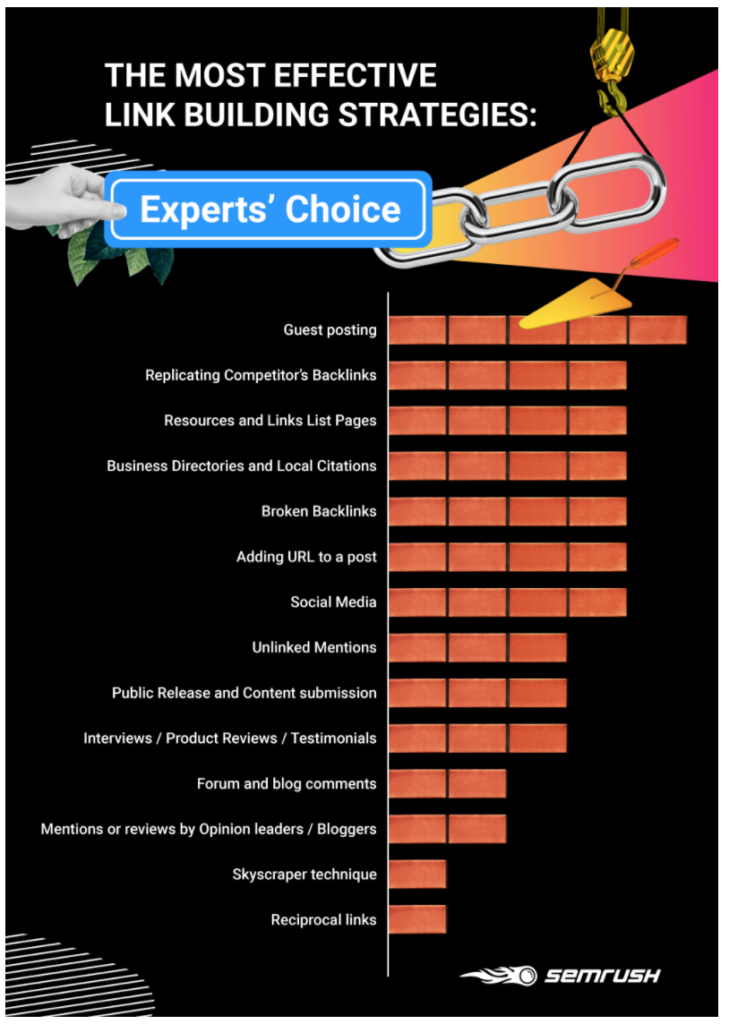
A function of old ways of operating?
But this could also be a reflection of what SEO professionals are used to.
Naturally, once we’ve acquired a certain level of expertise on something we tend to remain focused on what’s always worked for us even if other strategies and tactics might be better and old ones are becoming outdated.
With that in mind, let’s first explore what different strategies prioritize.
Then we can dive more into the tactics, where we can look into specific ways to build high-quality links to your site.
Link Building with “Quick Wins” in Mind
Link building takes time but it’s not that all link building approaches are resource-intensive.
While many are, if you’re looking for tactics that can help you quickly pick up some good links, you will find plenty of quick win types of opportunities.
For example:
1) The links that are the easiest to get also means they are also those that your competition will also likely reach for first if they don’t have them already. It is, of course, still better to have these links than not.
2) A quick win type of strategy often sees a high return to effort ratio.
3) These can help you build a quality foundation and put you on par with many of your competitors who have already put these tactics to work. Your site can be ranking, getting traffic, and generating revenue just by scoring the “easy links.”
4) Also, once you begin ranking organically, you will start seeing links coming in organically that are topically relevant and editorially placed. When you have no traffic with no or few links, this won’t yet be possible. Scoring the easy links will help you at least get on the map and not have an empty site.
Nonetheless, it’s important to keep in mind that this strategy is rarely sufficient on its own. This is especially true in competitive niches, where you may need thousands of great backlinks to see you land in the top rankings.
While it can build a nice foundation to work from, to take your organic search performance to the next level, you will typically need to move your strategy toward others once you have gotten the “quick win” links built.
Manual Link Building
Traditional link building tactics rely on manually placing a link on a different website.
That means the link builder is usually in full control of the outcome of the tactics. This contrasts to relying upon a journalist, webmaster, or other third party to want to link out to your site.
But it’s generally true that links that you are in control of typically aren’t of the greatest quality.
In Google’s eyes, any links that aren’t editorially placed (done at the discretion of someone else) are considered manipulative.
Therefore, they’re likely to either have less of an impact on rankings, be ignored, or could actually harm your site’s performance if done at volume.
That said, these aren’t necessarily bad links. Outside of the SEO impact, they can provide benefits such as referral traffic or help to establish your site as an authority.
Like anything, you should know the risks associated with these tactics, and use carefully.
And similar to quick win tactics, a strategy based around manual link building tactics is likely to be one that can be copied by competitors. As a result, it’s not going to give you a material advantage over your competitors.
Earning Links
If you really want to gain a competitive advantage through links, you need to adopt a strategy that will help you earn natural, editorially placed links.
Backlink earning tactics will require effort but provide a high reward.
Accordingly, you will need to be prepared to invest time and resources into earning these links. If you do, you will land quality backlinks that competitors will struggle to replicate.
Backlinks should be an indication of value, and earning links is generally the best display of such.
This echoes what’s written within Google’s Webmaster Guidelines:
“The best way to get other sites to create high-quality, relevant links to yours is to create unique, relevant content that can naturally gain popularity in the Internet community.
Creating good content pays off: Links are usually editorial votes given by choice, and the more useful content you have, the greater the chances someone else will find that content valuable to their readers and link to it.”
— Google Webmaster Guidelines (Link Schemes)
When you earn a link, a third party is actively doing so at their discretion. This means they are linking because there is a reason to do so. Namely, it adds value to their own audience.
Earned links are the best types of links and are essential to success in competitive industries and niches.
Paid Link Building
Paid link building is a clear violation of Google’s Webmaster Guidelines and a tactic that’s defined as a link scheme. Yet paid link building is still fairly common in 2025 because it can appear genuine and it can get results.
Earning links can be hard to do, especially for new sites because they have organic traffic. And if you have no traffic, nobody can link to it.
And even traditional manual link building and the myriad quick win tactics available still require effort to see results.
Some things to keep in mind:
- Paid link building is a violations of Google’s policy.
- It is a low effort but high-risk tactic.
- Most paid for links come from sites that are not in the same niche, and have a high number of outbound links. They are generally low quality.
- If you can buy links, so can your competitors, so be wary in terms of how much of a value-added tactic it really is.
There are some exceptions to the rule.
For example, if you are getting sponsored links because you’re looking to land referral traffic or build your thought leadership or brand authority, paid links could be an option.
You will, however, need to make sure you are doing so with sponsored placements on quality sites, and have either a rel=“sponsored” or rel=“nofollow” attribute in place. This rel= tag will prevent a negative impact on your search rankings.
As a general rule, paid links to help increase your rankings should not be done.
Some will do it anyway because they still want/need to build links and it’s lower effort, but just understand that it’s a higher-risk tactic and doesn’t provide a direct competitive advantage, as others can also pursue this general strategy.
Black Hat Link Building
Black hat link building strategies are typically used to manipulate search engine rankings. As we wrote above, black hat tactics often focus on unethical schemes that are in direct violation of Google’s guidelines and use such methods that are defined as a link scheme.
There is little to no focus on the user in black hat schemes, which Google is ultimately getting at and will reward the most long-term.
Those employing black hat tactics are looking to simply game the algorithm.
These tactics typically result in an algorithmic filter or manual penalty being applied. As algorithms continue to develop, they will also simply ignore links that don’t add value.
Black hat strategies aren’t sustainable and shouldn’t be considered a viable SEO link building option in 2025.
We won’t share black hat tactics in depth, as they shouldn’t be used and, if they are, their risks should be understood.
Common Black Hat Link Building Tactics to Be Aware Of
It is, however, important that you are cognizant of the type of tactics that fall under black hat strategies.
This will help you avoid them if they are recommended by any information source you come across or anyone you’re working with.
- Keyword-rich links that are placed within widgets on other websites you don’t own
- Links from sites that have been hacked
- Links built from automated services or programs
- Paid links without the rel=”nofollow” or rel=”sponsored” tag that are designed to pass PageRank
- Private Blog Networks (PBNs) — more gray hat, but black hat in style being a type of link scheme
- Guest posting and content marketing campaigns that use keyword-rich anchor text
- Spam comments
- Low-quality directories whose purpose is to build links from
- Requiring links as part of a contract or Terms of Service
- Widely distributed footer or sidebar links (sometimes common with certain types of designs)
“Quick Win” Link Building Strategies
The tactics below cover the lower effort, high reward tactics that won’t take a lot of time or resource investment to implement relative to others.
Given their ease to obtain, it could make plenty of sense to focus some of your efforts on these.
1. Broken Link Building
Broken link building is a classic building tactic that is easy to get started with.
It involves finding relevant pages in your niche that can link out to your site by replacing non-functional outbound links.
Broken links happen all the time as pages are taken down, URLs down, domains expire, and so on.
You can reach out to the webmaster and suggest that the broken link be updated to a piece of content on your site. If they accept, you can send them the link, or directly send it in your initial outreach message.
How do you find broken links?
There are different broken link monitoring tools. A quick way of monitoring your competition’s backlink profile for broken links is with the SEMrush backlink audit tool.
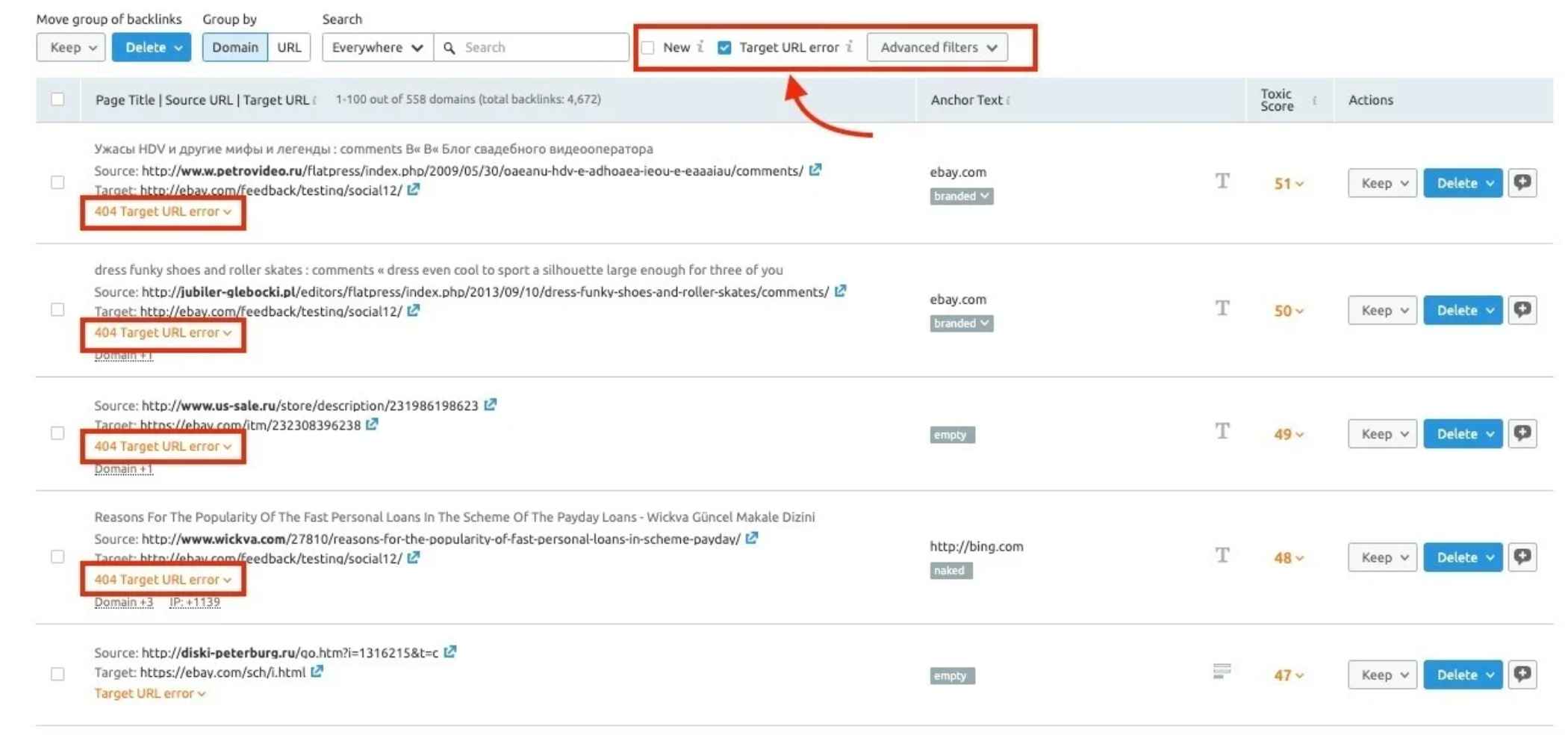
2. Brand Mentions with No Link
Most businesses are mentioned in the press for several different reasons. Some are natural references and others may come about as a result of PR, brand awareness campaigns, or outreach.
This coverage is often limited to a standard text mention with no link back to your site. The hard work is generally getting the mention to begin with. However, it is often easy to reach out and have this turned into a link with minimal effort.
How do you find brand mentions?
An easy way is to use the SEMrush Brand Monitoring tool
This way you can receive notifications whenever a site mentions you, but hasn’t linked back to your site.
Outreach for brand mentions
You can kindly email the webmaster or person who mentioned your site and ask them to place in a link.
Give a brief sentence about how the link will add value to their readers. This will help make their decision easier.
This doesn’t always work, as many emails go ignored (or aren’t received). Site owners may also be selective about who they link out to.
But considering the low effort, it can be highly worth your time to get some of these links.
3. Lost and Broken Link Reclamation
Backlinks come and go.
As time goes by, links get lost or broken. These occur for various reasons that are totally out of your control.
Sometimes content gets updated and the link is removed, it doesn’t carry over from a site update, or the page is redirected (e.g., links pointing to a 404 redirect won’t be counted as part of Google’s algorithm).
Whatever the reason, a site’s lost and broken links are valuable links you can potentially reclaim.
– If the issue is with another website, try reaching out if your contact at a site can go in and get a link added back to its former place.
– If a page on your own site has become a 404 redirect, either redirect this page to the most appropriate one on your site, make the original page live again, or reach out and ask for the link’s targeted page to be updated.
Finding and monitoring broken and lost backlinks can be done with the SEMrush backlink audit tool.
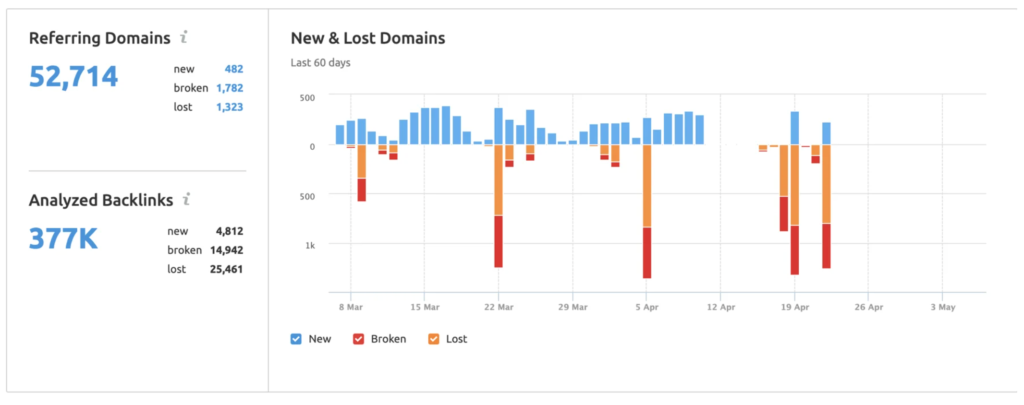
4. Repositioning Links
Link repositioning is not commonly talked about. But it’s a tactic that’s not difficult and can make existing links work harder.
This involves analyzing the links pointing to your homepage and looking at any that refer to the products or services that you offer, or the general content.
The goal is to find homepage links that would be better suited to linking to an internal page in your site, instead of the homepage.
The general idea is to analyze the content of the links going back to your homepage and write to those webmasters to get a more specific link.
If you have a general sports website and the link back to your homepage comes in the context of something about baseball, you might want to reach out and see if you can get that link pointing to the baseball section of your website or a more specific article, if appropriate.
Many will be nice enough to update the link, as it improves the user experience for their audience.
5. Links from Suppliers
If you sell other company’s products, there’s a reasonable chance that your suppliers and/or manufacturers link out to retailers from their own sites. These can be quick win backlinks to obtain.
Here’s an example from Chandler O’Leary (though it’s simply a list and no external links are provided):
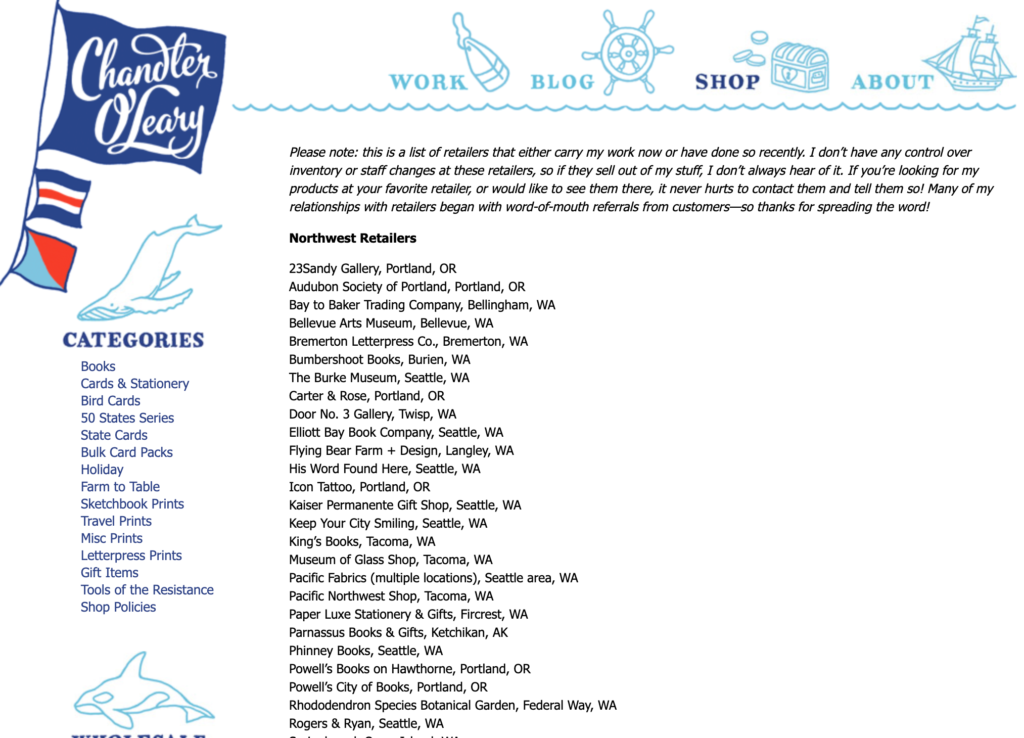
Putting together a list
Here you can pull together a list of all of your suppliers and manufacturers, then work through their sites to see if they’re linking to retailers.
If they are, is your business/store included?
You will also find that the retail partners they list aren’t updated as frequently as they should be. Retailers are often missing.
If you don’t see your business listed, you can reach out to a contact you have at the supplier and ask whether they can get a link to you added.
6. Membership Links
Are you a member of any industry association?
If you are, these organizations often link out to their members. If you are not already listed, it may only take an email to request your addition to the list.
7. Internal Linking
Internal linking is a bit different tactic.
Usually when we reference link building, our efforts are focused around building external links.
But an additional quick win tactic can involve improving and optimizing your site’s internal linking structure.
Internal linking is used to distribute PageRank throughout your website. If you have earned links to certain pages, you can help pass on some of this authority to related pages.
Internal linking is also something that’s totally at your discretion and requires no input or collaboration from third parties.
It’s also something that you can do continually. As part of your content editing process, adding in links to other articles on your site that can improve the user experience can be worthwhile.
8. Links from Q&A Platforms
Link building should be as much about tactics that can send you quality referral traffic while helping your brand as it about improving your positioning in the SERPs.
While these tactics will land you nofollow links only, using Q&A platforms like Reddit, Quora, and specialty forums within your niche are great ways to build links.
They can send targeted traffic to your site, increase brand awareness, and may even net customers. These links will also help diversify your backlink profile.
Within these communities, just be sure to add value. It’s not about just jumping in and adding links but sharing content and quality replies to those who have questions and need guidance. Some platforms will also crack down on users who are primarily or exclusively there to market their sites.
9. Reclaim Links from Reverse Image Searches
Have you created infographics or published custom graphics as part of your content strategy in the past?
You can go over to Google Images and run a reverse image search.
If other sites are using your images but you haven’t received a link, you can email them and ask them to add one.
Traditional/Manual Link Building Tactics
There are SEO link building tactics that were once broadly used to the point where they were abused and accordingly have come under scrutiny in recent years.
They usually fall under the magnifying glass because they don’t result in links that are earned. Instead, the link builder had active involvement in the link’s placement.
These tactics won’t necessarily result in bad links back to your site, but understanding how each one fits into your strategy and what scale to apply it on is essential.
1. Directory Submissions
Directories were once set up for the sole purpose of building links.
Some coupon code sites are effectively link directories:
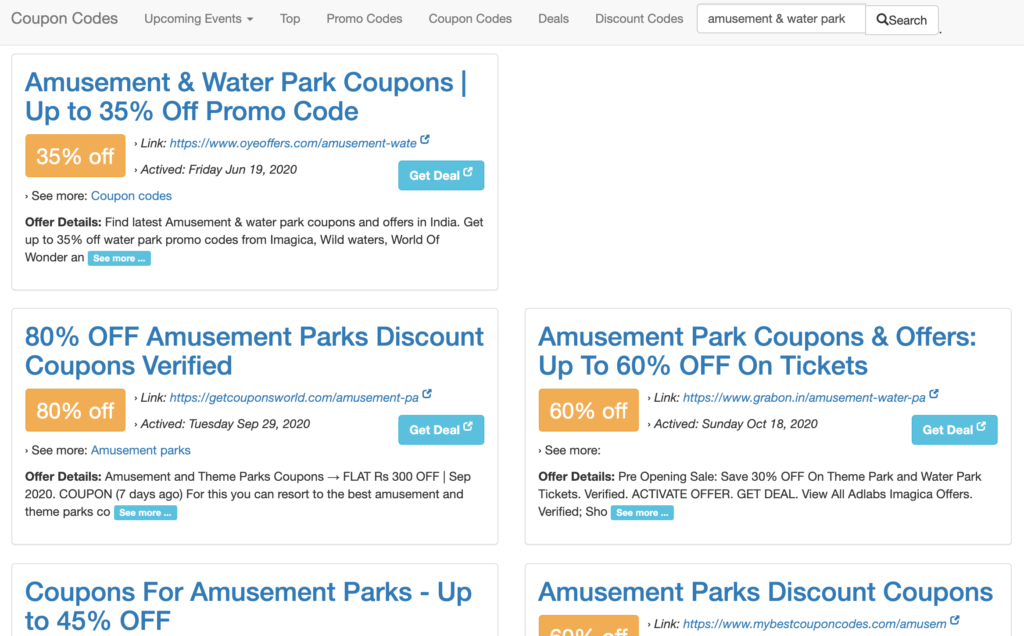
A matter of value
With many of these sites, there is no actual value provided to users, and the site simply exists just to link out to others.
Some directories will be considered part of a link scheme and you don’t want to be building links to these types of them.
At the same, you shouldn’t dismiss the directory submission tactic as it’s still a great way to generate some high-quality links. This is especially true if you are operating in a small niche or are part of a local business.
Your best options in this space is to look for specific regional directories or those that exist within a particular industry.
Thinking again from the referral traffic perspective – is this a place where you could pick up potential customers? And if you were a potential user, would you find the link useful?Depending on your answer, you’ll be able to tell whether it’s worth having your site featured on.
2. Guest Posting
Guest posting, also known as guest blogging, has been around a long time. Google representatives announced that guest blogging was being cracked down on way back in 2014 due to the way it was being abused.
Site owners were putting links in the bylines of articles of practically any site that would accept their content.
Guest blogging remains a quality way to get links in 2025, as long as it’s used prudently and is not scaled up to a point where it could signal something unnatural.
Again going back to the referral traffic mindset, focus on blogs that are topically relevant where you can share valuable insights and expertise with an audience you could appeal and add value to.
That you might be able to get a valuable link back to your site is an additional plus.
How to find guest posting opportunities?
A quick search on Google can provide a range of posting opportunities. Below is a “write for us” example in the travel niche.
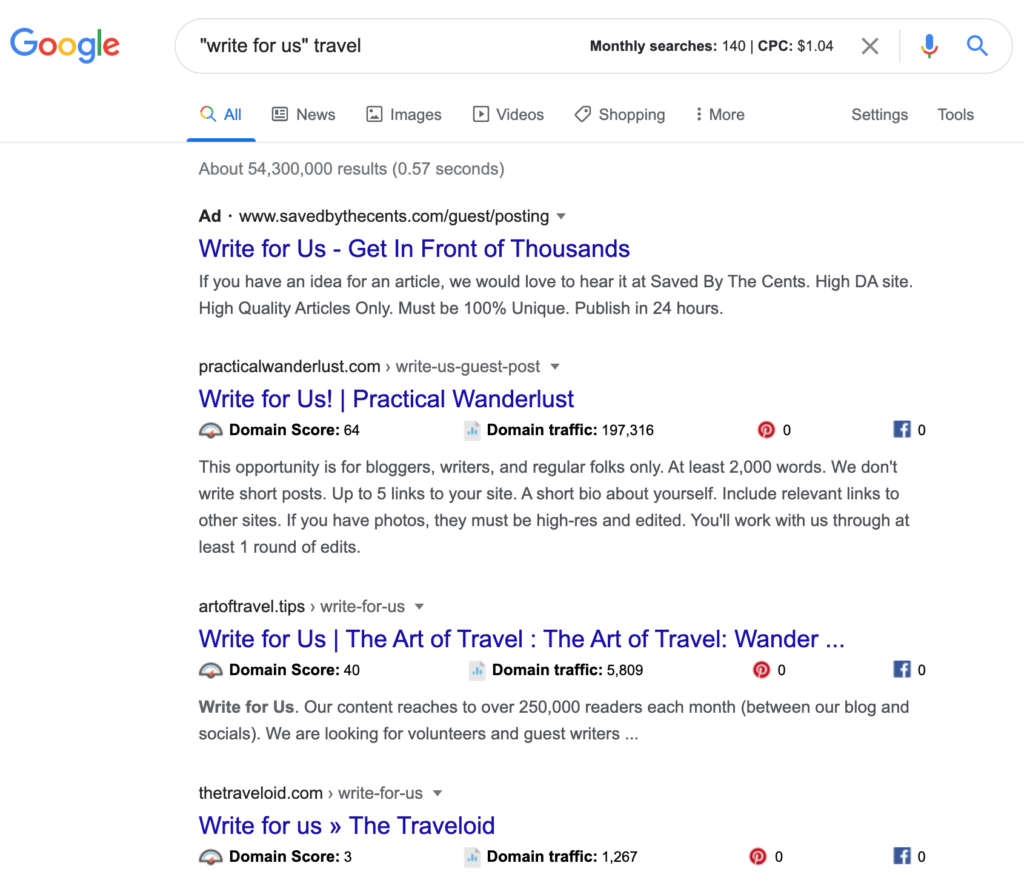
Guest blogging is also a strategy that’s widely used to the point where it’s not likely to yield a competitive advantage. Your competition can use the tactic as well. It also consumes time dedicating the resources to a piece of quality content.
3. Content Syndication and Press Releases
Google has stated that they don’t like links coming from press releases.
The issue with Google is when sites use press release distribution services to syndicate your content to a number of different sites to pick up multiple links.
This is a tactic that may have had some value in the past, but times have changed. If you are using PR wire services solely to build links, there’s a reasonable chance you won’t see much or any value back for those links.
However, you should still be pitching out to the press to earn coverage and links.
4. Blog Comments and Forum Links
Blog comments and forum links are now mentioned as types of links that violate Google’s Webmaster Guidelines.
But this is a tactic that’s open to debate.
As we’ve written a few times, always think in terms of value and whether leaving a link in a certain spot would help increase quality referral traffic.
Non-topically relevant blogs are not worth placing a link back to your site. Forum posts that don’t add value are spam.
You can still earn traffic from quality, relevant comments and forum posts. But this comes when you approach the tactic as a way to add value to discussions and link only when it adds value.
5. Link for link (reciprocation)
Reciprocal links where two site owners agree to link to each other are another example of link schemes and a violations of Google’s guidelines.
One-off reciprocation probably isn’t going to penalize your site. For example, if you have an opportunity to send referral traffic to a partner in your niche via a link, and they will do the same for you, it’s not going to harm your site.
But it’s not a tactic to do at scale.
Context and topical relevance are key.
Earned Link Tactics
Earned links are the best type of SEO link building you can do. Third parties who link to you are doing so because you add value and are relevant to their content.
When someone is making a conscious decision to link to your website in particular, rather than someone else’s, this conveys authority.
Landing earned links is something that your competitors will struggle to replicate because of the value your content creates.
These are more advanced tactics, as they deliver the best results for those prepared to put in the effort to learn how to leverage them.
1. Digital PR
Digital PR has risen rapidly as a link building tactic in SEO circles. It came about as a way to earn high authority links by using PR tactics in conjunction with press publications.
Digital PR is the most effective way to naturally earn material amounts of high-quality editorially placed links at scale.
It involves creating engaging linkable content and using PR pitching and outreach to persuade writers and journalists to cover these stories in their articles while linking back to the source (i.e., your content).
There are different ways to run a successful digital PR campaign. We’ll look at four of the most effective approaches.
Data-Driven Studies
Building digital PR campaign around data will enable you to have a wealth of engaging stories to pitch to the press.
Journalists love linking to data, which is how and why some “pure data” sites (e.g., tradingeconomics.com) can generate so many backlinks and rank so high for so many different keywords in their niche.
The best stories and pitches to journalists are those that include something that they couldn’t otherwise do on their own.
Journalists are busy people, often tasked with writing 5-10 articles per day on various types of events and on various posts of different lengths. That includes sourcing quotes, finding images, producing copy, and communicating with editors.
Using data means you are sharing stories that can’t be easily replicated and are backed by findings from research, analysis, or a study. Journalists love this because it gives their article authority.
Data sources to use in your PR campaigns can range from your own internal data based on whatever your business is about through to credible and trusted third-party public data sets.
For example, SEO posts that are backed by tons of data naturally get lots of backlinks and shares, like this post from BuzzSumo on analyzing 100 millions headlines.
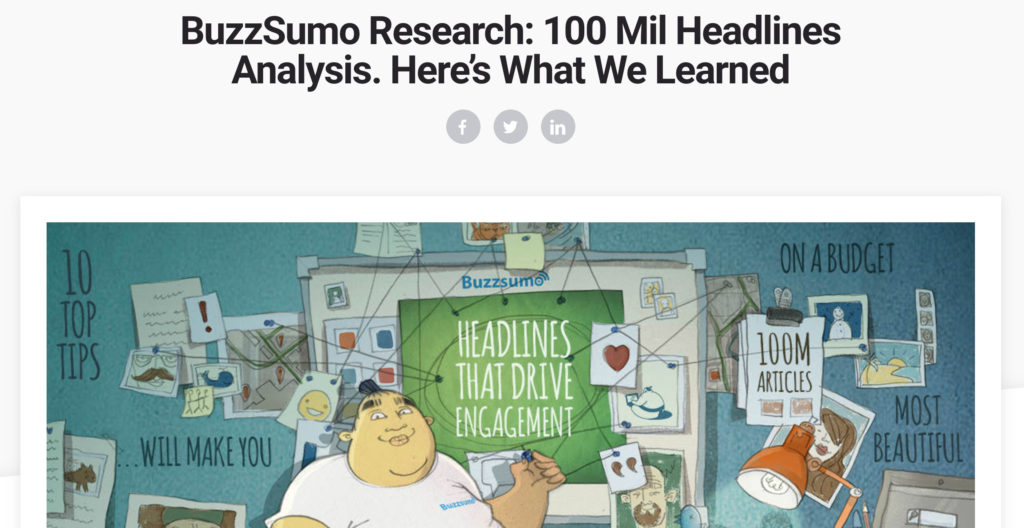
This digital PR campaign earned links from 100+ publications.
Infographics
Infographics are not as popular as they were in the mid-2010s. When they were new to the scene, they made it easy to earn links from high-authority press publications. Even simple how-to infographics that taught people how to do a particular task could easily pick up large numbers of links with only a little bit of outreach effort.
But times have changed. The buzz led to a bit of overuse and the content form became more saturated. Accordingly, you are unlikely to see much of an impact with simple advice- and opinion-based infographics (e.g., how-tos and listicles, etc.).
But as long as they display value, infographics can still be effective.
Things to keep in mind:
- What kind of value can people get from it?
- The infographic should be a simple way to visualize your content in an easy-to-share format.
- An infographic is just a format. When used to tell a story and it flows effectively, you can still see success.
As an example, this infographic shows who owns the various elements of the mainstream media in the US. It’s been effective given how well it can visually illustrate an otherwise complex set of relationships.
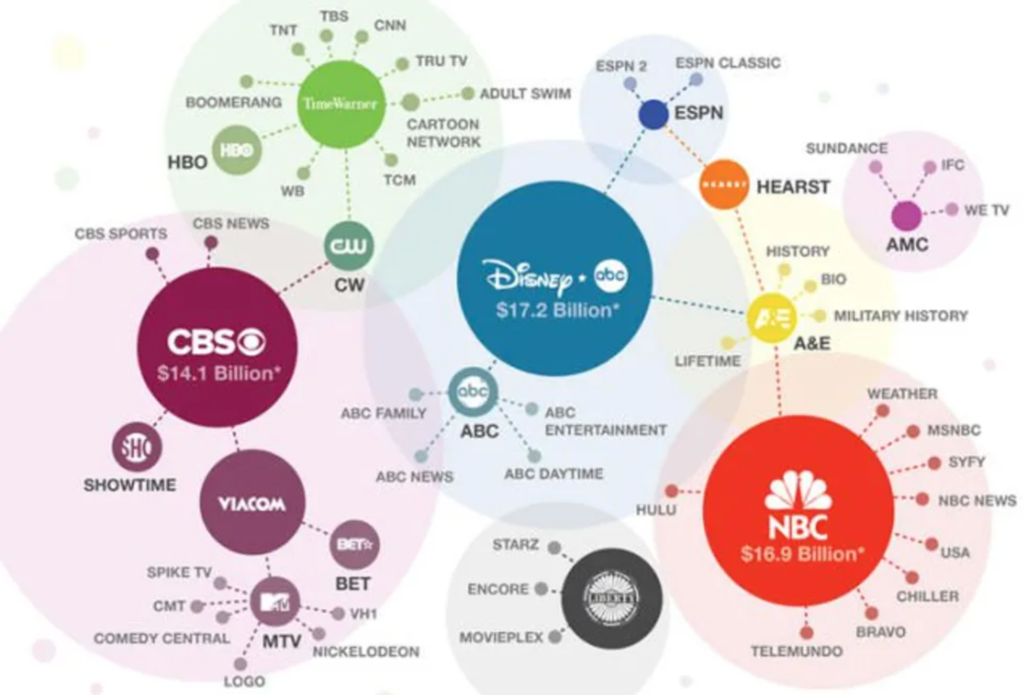
Interactive Tools and Assets
If you have the resources to do so, launching interactive tools and assets can be a great way to earn high-quality links from the press in impressive numbers.
These can be something as basic as a mortgage calculator.
For investment portfolio analysis, Portfolio Visualizer enables you to see how a portfolio would have performed in the past and allows you to perform a Monte Carlo analysis of how it might perform going forward. Various other financial tools are also available.

When you create an engaging, interactive tool, asset, or piece of content, you are essentially making the link an essential part of the article. It’s unlikely that a journalist would mention a great tool but not link to it, making this a great approach and one that can be difficult for your competitors to copy.
Surveys
If you are looking for a way to launch a digital PR campaign that gets people talking, surveys can be a great way of finding out the public’s opinion of a topic.
Surveys align with more traditional PR tactics. But they are still a way to drive coverage to your brand and earn links from the press.
Ensure to write up your findings – and visualize them, if possible – as a piece of content, rather than just pitching out the results as a press release. This way you can ensure you earn links for your survey results and not just brand mentions.
2. Resource Link Building
Occasionally you don’t need to create content, studies, analysis, or data-driven campaigns to earn high-quality links.
If you can identify where your business can add value to your audience, you can leverage this to build links from resource pages.
This is common among travel and tourism boards, colleges and universities, and local and municipal governments.
Competitor analysis can often help to find resources that are linking to your competitors but not to your site.
You can take this a step further by searching for similar opportunities yourself.
For example, Borders of Adventure provides a resources page for travel information.
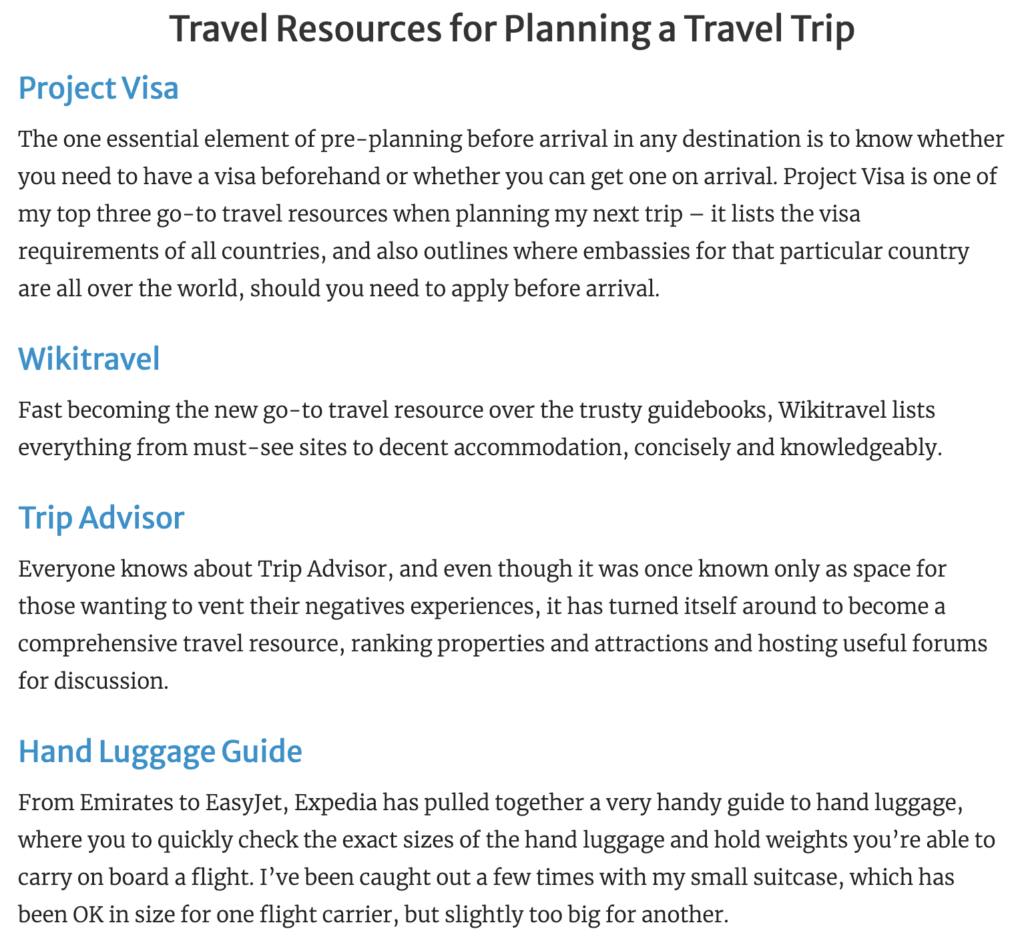
It includes a number of external links to travel destination sites and various travel guides, making it a perfect target for those with related content in that niche. Like always, just be sure that the link you propose adds value to the page. That could be either through a piece of content or travel guide or simply the core offering of your business.
3. Case Studies and Testimonials
Case studies and testimonials can be a great way to earn links simply by publishing a brief summary of why you like the product or service.
This testimonials tactic is often based around pre-existing relationships. Namely, you offer to share your thoughts on their product or service to help them to sell more.
Alternatively, you could give them permission to feature you. And in doing so, you can often land a link in return. Not all links will be “dofollow” in nature.
4. HARO (Help a Reporter Out) and #journorequest
By monitoring HARO and the #journorequest hashtag on Twitter, you could find opportunities to land press coverage (and backlinks) for your client or business.
These enable journalists and content creators to find sources for their articles and links, referral traffic, and/or awareness back to their sites.
Journalists are looking for businesses and experts to add value and provide insights into their content. It is a tactic that you should ideally be taking advantage of.
HARO will send out multiple emails per day that include requests by category, or those just from a category you have requested to receive notifications for.
If you believe you can provide a great response to the request, go ahead and send it over.
You won’t find all of your responses are used. But it’s a relatively low-effort tactic that can provide quality results in terms of obtaining high-authority links.
Just ensure you are only responding to requests where you can truly provide expert comment.
#journorequest works similarly, with journalists using the hashtag on Twitter to obtain sources. Naturally it requires a Twitter account.
5. The Skyscraper Technique (and Reverse Skyscraper)
The Skyscraper Technique was coined by Brian Dean of Backlinko.
It has gained a large amount of traction within the SEO and link building community. It essentially involves building on an already popular piece of content getting great traction.
It involves three steps:
i) Finding content that has performed well with high amounts of social shares and backlinks.
ii) Produce a piece of content that is even better than the original piece.
iii) Reach out to sites that covered it and ask them if they’d link to your new and improved content about the topic.
It is based on creating the best piece of content on a topic and leveraging it to obtain links from those who linked to the original.
There’s also what you might call the reverse Skyscraper technique.
It is based on a similar concept, but rather than finding content that performed well, you will look for content that didn’t perform as well but that has the potential to. Essentially great content but less than optimal execution.
After it’s completed, go ahead and create content around this topic and tell relevant site owners and publishers about it.
6. Newsjacking
Newsjacking is known as reactive PR.
It’s a technique used by public relations professionals involving reacting to breaking news stories quickly, and identifying opportunities where you can provide expert commentary on that topic or story.
Newsjacking basically involves brands ‘piggybacking’ off news stories to get attention on a piece of content, or to earn coverage or links for a brand’s homepage.
Newsjacking is all about reacting quickly and ensuring that it’s relevant to your brand.
7. Interviews
If you have an industry expert within your business or your client’s business, securing interviews with industry-specific publications can be an excellent way to not only obtain a quality link but also to get thought leadership.
Google search is a great way to find these opportunities and don’t just limit yourself to written interviews. Videos and podcasts are also great and can be accompanied with a link back to the guest’s website.
8. Round-Ups
Content round-ups are common in most industries.
Round-ups are simply lists of the best content in a sector over a period (past week or month usually). They are often pretty easy to find using Google search commands, such as:
– “Keyword” + intitle:“roundup”
– “Keyword” + intitle:“weekly roundup”
– “Keyword” + inurl:roundup
You’ll need to make sure you have already created great content that is worth being featured and reach out to suggest it for inclusion in their round-up post.
9. Expert Round-Ups
Despite overuse in the past, expert round-ups can still be an excellent way to earn links.
You’ll need to round up a series of experts within your industry (like a reverse content round-up, where you are the one creating the content) and ask a series of questions to them and turn it into an engaging piece of content that takes the opinions and insights of various industry leaders.
There are also often interesting angles and debates you can take that industry publications love.
As long as you choose the right thought leaders who have credibility and expertise, it’s a great tactic to use. It also helps position your brand as more authoritative.
Paid Link Building Tactics
It’s important to know that paid links violate Google’s Webmaster Guidelines unless they are marked using either rel=”sponsored” or rel=”nofollow” attributes.
This prevents them from passing PageRank.
We’ve already gone through the risks of paid links, which are used as a shortcut, and won’t be sharing these here.
With that said, there’s still an opportunity to use paid links to build your brand and earn referral traffic.
Essentially this is what these tactics are ultimately used for.
1. Product Reviews (when product distributed as a gift)
To Google, links earned from a product being gifted to a reviewer are classified as being paid/sponsored.
While there is no money directly changing hands, there is an implied transaction as there is value to the product owner by putting in a good word.
Like sponsored blog posts, gifting products to influencers can be an excellent way to expose your brand to new audiences. But ensure that any links include a rel=”sponsored” attribute.
2. Sponsored Blog Posts
Suppose there is an influential blogger in your niche who has made a name for themselves and earns hundreds of thousands of page views every month from your target audience.
It is unlikely that they are going to link to you for free or at your request.
They have spent time and resources building up an audience, and they generally do not give that exposure away for free.
Accordingly, you might want to work with influencers to publish a sponsored piece of content or blog post.
This is where they will feature and link to your business in exchange for payment.
– This can be great at exposing you to new audiences and generating you referral traffic. This is true not just for blogs, but also conceptually the same to video platforms like YouTube as well. Two YouTubers doing a collaboration on their channels can open up their audiences to each other.
– Ensure that the link uses the rel=”sponsored” attribute to clearly mark that it’s a paid collaboration.
– Advertorials and guides with popular news publications work in the same fashion.
– These links aren’t for SEO, but for referral – exposure and brand building.
3. Scholarships
Scholarships can be a way to build links. This was especially popular around 2015 but became another tactic that was been abused to get .EDU backlinks, which tend to be particularly authoritative. Indirectly, it’s a paid link building tactic because a monetary reward (the scholarship) is exchanged for the link.
It involves putting together a scholarship fund of a certain size (usually above $1,000 to make it worthwhile for educational institutions to publish) and listing the requirements and offering on a dedicated page on your site. That way these institutions can link out to you.
This is before reaching out to colleges and universities that list current scholarships and hoping that they link out.
Example email copy might read something like:
“Hello,
I’m excited to let you know about a new scholarship opportunity for <<School Name>> students. It can be found at the following URL link:
<<URL>>
Our scholarship is called the “<<Name>> Scholarship Award,” and it’s designed to help students in finance, accounting, economics, business, and related majors. [Or whatever it’s about]
Here is a brief list of our requirements:
(1) Short-response essay submission in Word or PDF format, or as a URL hyperlink
(2) Contact information (name, mobile phone number, other) in the body of the email
(3) Proof of enrollment in an accredited US college or university
We would be honored if you’d be kind enough to add our award to your scholarship page << school scholarship page URL>>
Of course, we’re here to answer any questions you may have.
Thank you,
<<Name>>”
It’s popular because it is a proven way to obtain links from educational institutions and those you wouldn’t normally otherwise be able to get links from. Unfortunately, it’s a tactic that’s been abused and overused.
Scholarship links very much into the ‘gray hat’ category. While you aren’t paying directly for a link, it’s the primary reason why you are setting up a scholarship fund.
Be sure you don’t abuse the tactic by trying to use it at scale. Otherwise, it can still help you to build some high-quality links.
4. Sponsorships
Sponsoring a conference of local event, as an example, is a tactic that is relatively commonly used to build links.
It is unusual for sponsorships not to be featured and linked to URL-wise. Once again, they fall into a gray hat area.
The event or organization that you’re sponsoring should align with your business.
You will enjoy benefits aside from just a link. If you are only sponsoring as a way to obtain a link, you need to ask yourself whether that investment could be better used elsewhere, especially if the links you will get don’t topically align with your niche.
How to Use Outreach for Link Building
In almost all of the SEO link building strategies that you’ll use, you will need to use email outreach as a way to open up opportunities and discussions and to actually obtain links.
From pitching to journalists and the press to running an outreach campaign to land guest posting opportunities, it’s all a lot of the same process.
To really master link building, you’ll need to get good at outreach, or you will need to work with someone who is.
What is Outreach?
Outreach for link building is simply when you identify people in your niche or industry (be that site owners, blogger, influencers, journalists, and other relevant media individuals) that might be interested in linking to your site.
Reaching out to them to build a relationship and explore opportunities for covering your content is a good approach. This can come before asking for links directly (a shorter-term and lower-probability approach) to build rapport for the sake of building something longer-term.
At the same time, content can mean different things.
It might mean that your outreach is to offer exclusive interviews with your company’s CEO or other executives. It could mean standard blog posts, or guest post articles. Or it might mean your latest data-driven digital PR campaign.
In simple terms, outreach is the process of identifying and connecting with those potential prospects who might link back to you.
Tips for Successful Outreach
There are a few key components of successful outreach.
i) Finding and identifying the right prospects.
ii) Writing subject lines that will see your emails get opened at a high rate.
iii) Writing convincing outreach email copy that encourages the recipient to take action.
It’s a process that requires testing out your own approaches, and should be tailored to the specific link building tactics you’re using.
It’s always helpful to personalize outreach emails as much as you can and clearly outline the action you want the individual to take.
If you want them to add a link to an existing piece of content they have or replace an old/broken link, cover your story for the publication they write for, or accept your guest blogging proposal be sure to make it clear in your outreach email copy.
A study by Fractl found the value that publishers normally see in pitches:
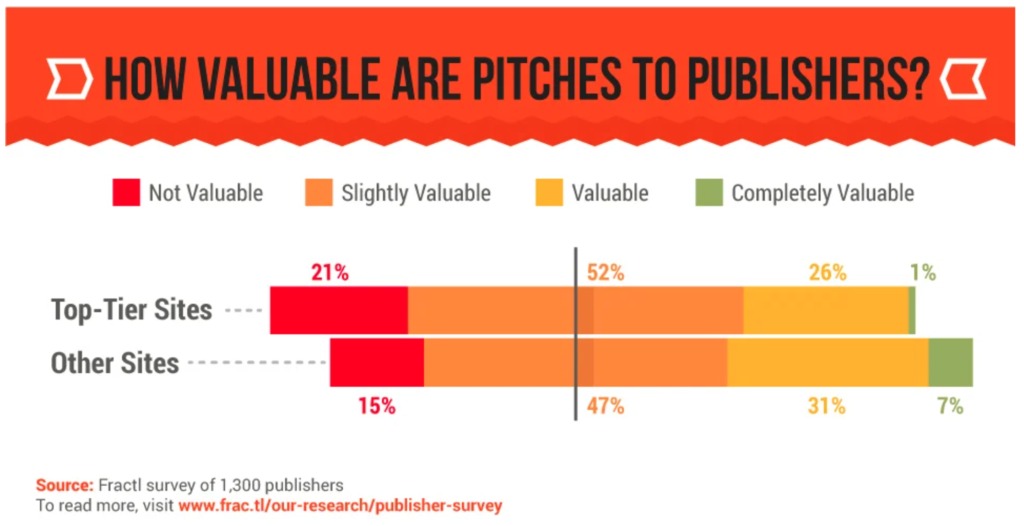
Maximizing outreach efficacy
While outreach is a tactic vital to helping you build and obtain great links, it takes time to perfect your approach.
One thing that helps the success of any outreach campaign is the quality of your outreach list.
It’s important that you’re prepared to put in the time and effort to find the right prospects, using tactics such as:
- Analyzing and monitoring your competitors’ backlink profile.
- Finding journalists and other bloggers who covered other stories in your industry or niche.
- Using a media database to find relevant prospects.
Building a targeted outreach list will drive better results than larger, non-specific lists that often feel like you’re throwing as much as possible against a wall and hoping that something sticks.
Do your research and know how your outreach pitch adds value to the recipient.
3 Ways to Find SEO Link Building Opportunities
We have been through quite a few link building tactics that should provide some ideas on how to build great links.
But how do you start finding link building opportunities?
1. Using Google Search
Whether you’re looking to use guest posting, link round-ups, industry-specific directories, or other places to obtain links, Google is usually the best place to start like many other initial queries.
You won’t need any tools, and you can usually find plenty of opportunities in just minutes.
You can then use search operators to return the results and opportunities that you are looking to find.
Looking to write guest blogs? Try these example search operators:
- [keyword] intitle:“become a contributor”
- [keyword] intitle:”guest post”
- [keyword] intitle:”write for us”
To find resource link opportunities, try these:
- [keyword] (intitle:”resources”| inurl:resources)
- [keyword] intitle:”useful links”
To find content round-ups to share your latest piece with:
- [keyword] intitle:”round up”
- [keyword] intitle:”weekly round up”
- [keyword] “best blogs of the [unit of time]”
2. Backlink Analysis
You can use the SEMrush backlink gap tool to find opportunities to obtain links that your competition has but you may be lacking.
In fact, it’s a great way to identify the links that could be helping your competition rank. If there’s a link in place to them, there’s a reasonable chance you’ll also be able to grab a link from the same site.
You can add up to five competitors to the tool, and you’ll see custom recommendations to help you analyze more links.
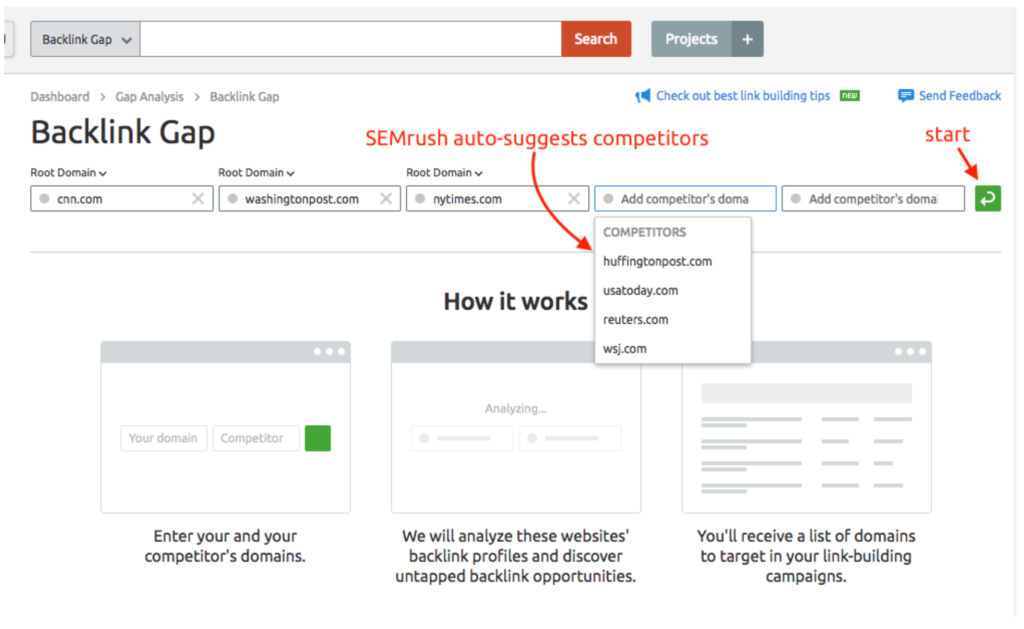
You’ll then see various insights into your various competitors’ backlink profile.This includes those who have earned the most links, the Authority Score (AS) of each, and which sites have been able to get links from the domain.
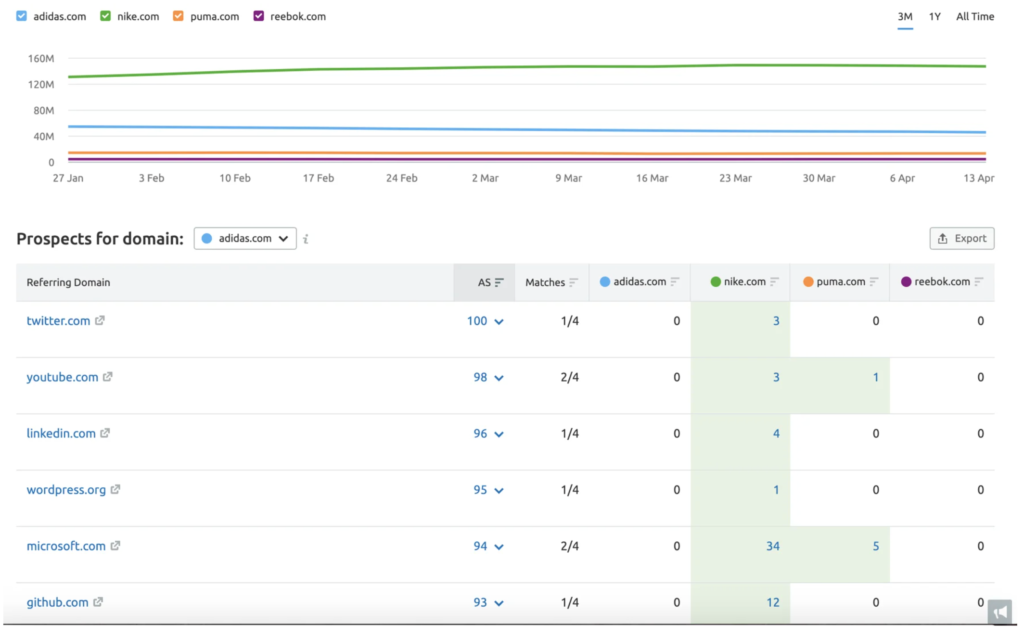
This is a quick and easy way to find potential reach-out where you have an increased chance of landing a link. It can also give you the insights needed to figure out your competitors’ strategies and understand the tactics they may be using to build links.
3. Look at Your Competitors’ Most Linked-To Pages
Having insights regarding the types of content that your competitors – and others in your niche, whether a direct or indirect competitor – are using to earn links is valuable to help determine your own SEO link building strategy.
If others in your sector are using digital PR content assets with a data-driven focus, you should be doing the same to get links of a similar or better quality through engaging content of your own.
You can find pages on other websites that have been linked to the most using SEMrush’s Backlink Analytics tool.
Go to the indexed pages tab and sort by the number of referring domains. You will then see the site’s pages where it gets the most links.
Take a look at each page and make sure that you exclude boilerplate webpage – e.g., policy pages, disclaimers, and so on.
Looking at content pages will offer some insights that you could be using in your campaigns.
Measuring the Success of your Link Building SEO Strategies
The success of a link building campaign is different for different sites and site owners.
It boils down to the goals of your campaign. It’s nonetheless important that you understand the metrics that should be considered when setting these goals.
Raw numbers of links built is not a good metric or barometer of success. Those who tend to focus on this metric almost always sacrifice quality.
You should be using competitor insights to determine the link gaps you have between you and others and make sure you are building quality, relevant links that actually increase your rankings.
When looking at link- and site-related metrics, you want to consider using one or more the following:
– Authority Score – This is SEMrush’s own metric that grades the overall quality of a website and gives you an idea of how much influence a backlink from a site can be for your SEO.
– Topical relevance – How relevant to your niche are the sites that you’re obtaining links from? Links that come from pertinent content are generally more valuable, again going back to the “quality of referral” concept. If such a link contained no SEO benefits, would it provide value to the user?
– Unique referring domains – You don’t want to be earning links from the same domains. It can also be a spam signal or show a direct relationship between the two sites. You should focus on increasing the number of unique referring sites in your link profile with other topically relevant sites.
– The ratio of dofollow (i.e., follow) to nofollow links – Your link profile should ideally contain more follow links than nofollow links. The former pass on authority while the latter don’t. The diversity in links is nonetheless good to have. Nofollow links from well-visited pages that can pass on quality referral traffic are also highly useful (e.g., Wikipedia).
– Toxic links – Toxic links is another SEMrush metric that indicates whether a link could pose a risk to your site’s organic search visibility. You want to avoid toxic links in your backlink profile. If you do, you will need to clean them up or at least ensure they’re only there on a very limited scale. Moreover, you can minimize toxic links by leaving the link building in the hands of yourself or only those you trust to do the job well. Having links built from an untrusted source may result in spammy link accumulation that can do more harm than good.
You may want to consider goals such as brand exposure, planting yourself as an authority, and placements on certain publications, referral traffic, and more – it is all about measuring those things that matter to you as a business.
Conclusion
In this article, we provided SEO link building strategies and tactics that work (and those that don’t) in 2025.
Ultimately, these insights need to be put into action.
If you have never built links before, there are some low hanging fruit you can try to get your first link.
If you’ve been building links for years, there should be at least one new tactic you can employ or delve deeper into.
Link building is not an easy endeavor and the tactics you use will continue to evolve.
With different available approaches, you can build a diverse backlink profile and maximize different opportunities as they come up and depending on what your business is all about and best suited for.
Link building is what most SEOs find the most difficult. As you become a better link builder and show a track record of success in link building, your skill set will be in demand as a marketer, SEO consultant, or site owner.
It’s a skill set that can turn small non-revenue earning sites into large, money-making, authoritative sites.
Appendix: Link Building SEO Strategies
Throughout this article, we used SEMrush as our competitive intelligence tool.
 |
SEMrush |
SEMrush offers solutions for SEO, app store optimization (ASO), pay-per-click (PPC), content ideas, social media, marketing automation tasks, and competitor research.
The SEMrush platform is perhaps best known for shedding value-additive insights on your competitors’ SEO tactics.
With SEMrush, marketers can find insights on:
- domain analytics
- keyword analytics
- topic research
- gap analysis
- SEO position tracking
- content templates
- writing assistants
- lead generation
- CPC map
- Traffic Jet (ad automation solution)
- marketing calendar
- project dashboards
- custom reports, and more
SEMrush is trusted by over 6 million marketers worldwide. SEMrush offers a Free Trial.


